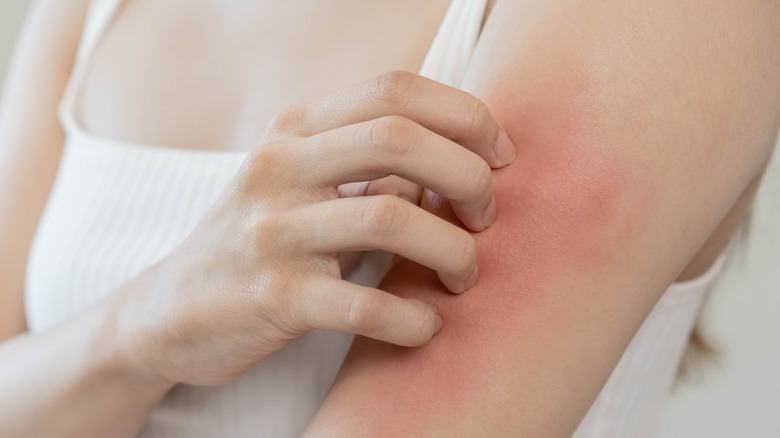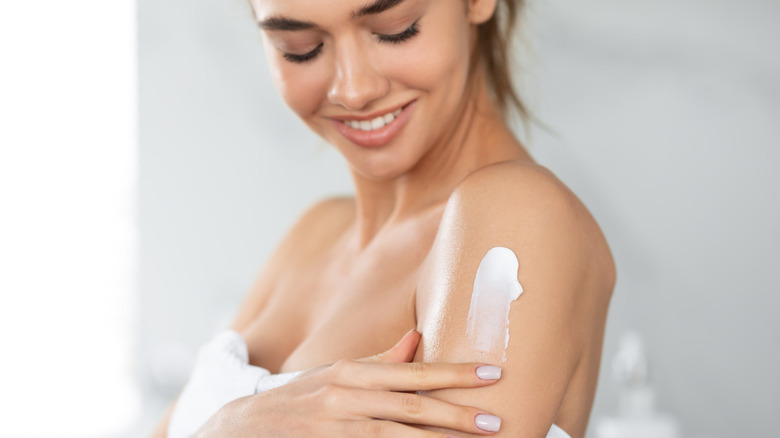What Is Colloidal Oatmeal And How Can You Use It?
If you had chickenpox or eczema as a child, one of your parents may have coached you through an oatmeal bath. You emerged from the tub feeling a little sticky or slippery to the touch. You could have sworn that your skin had a protective film over it. Either you didn't know what you were experiencing or your parents didn't, but parents are supposed to know better. It turns out that they were smarter than even they realized.
Generations of parents have turned to oatmeal baths to help their children find relief from skin dryness, redness, and itching. All along — and, in fact, for centuries — people have used colloidal oatmeal for the same reasons: for relief from common skin conditions (via Heathline). It wasn't until the U.S. Food and Drug Administration officially moved to classify colloidal oatmeal as a "skin protectant" in 2003 that you could say the oatmeal finally got the vaunted recognition it deserved. It's especially notable for an all-natural treatment, not to mention one made from ground oat grain that is crushed into a fine powder. As much as you may enjoy learning about colloidal oatmeal, you can make a real splash once you learn how to prepare it yourself.
Oatmeal boasts emollient
It's no wonder your skin felt a little slippery after taking an oatmeal bath. Colloidal oatmeal is an emollient, an ingredient that soothes and softens the skin. And this is where vocabulary becomes important. Many people use the words "moisturizer" and "emollient" interchangeably. But they are not the same thing, Healthline notes. An emollient is one of the ingredients in moisturizers. Colloidal oatmeal consists of even more elements that nurture the skin, like fats, minerals, proteins, and vitamins. You can probably see how such an oily, protective barrier acts like a guardrail against moisture loss. In addition to providing relief for dry, rough skin, colloidal oatmeal may calm the urge to itch (via Medical News Today).
People with a variety of skin conditions have learned firsthand how effective colloidal oatmeal can be. Healthline says these conditions include chickenpox, dermatitis (eczema), xerosis (severely dry skin), and burn-related itching (though not severe burns). Even people whose radiation treatments have dried out their skin have turned to colloidal oatmeal for relief. All this may sound too good to be true, but the script gets even better. Most people find colloidal oatmeal to be safe, with no side effects, unless they're allergic to oatmeal. And what could happen if you eat it by accident? Nothing, except that the extra bland taste may cause you to reach for a bowl of your regular oatmeal instead.
How to mix an oatmeal bath
Colloidal oatmeal might make you feel like a turn-of-the-century pharmacist, grinding down a prescription and then filling it so the patient can feel better in no time. All you need is some whole, uncooked oatmeal and a blender or food processor. First, pulse the oatmeal until it's reduced to a powder (via Healthline). Before you start to fill your bathtub, test the consistency of the oatmeal. Mix 1 tablespoon of oatmeal with 16 ounces of water. The water should turn white, like thin milk. If it doesn't, add more oatmeal to the blender or food processor.
When you're ready to pour your oatmeal bath, fill your tub with tepid (lukewarm) water while you sprinkle about 1 cup of oatmeal powder inside. Don't use hot water, even if you prefer it, because the temperature could aggravate your skin condition. Soak for about 15 minutes in the tub, gently splashing the water all over your skin (via WebMD). When you're done, pat your skin dry with a towel and apply a moisturizer formulated for sensitive skin as the crowning touch. Just be careful getting out of the tub and walking around it. Colloidal oatmeal will do exactly as advertised, leaving behind an oily film, which means it may make your tub and floor slippery, too. If you move slowly and carefully, however, the only thing you ought to fall for is the healing power of colloidal oatmeal.


